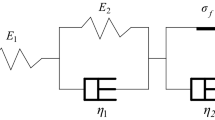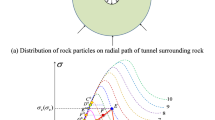Abstract
Accurate prediction of surrounding rock deformation can effectively prevent tunnel failure. To accurately predict the displacement of soft rock, an optimized prediction model is proposed, which simultaneously considered the phased release of geostress and the characteristics of soft rock. The existing stress release formula is modified based on the stress release law of three steps excavation. Considering the softening effect of soft rock, the softening factor is established and introduced into the Mohr-Columb strength criterion. At the same time, the influence of the expansion effect and rheological effect is considered in the derivation. Analytical model is used to verify actual soft rock tunnel engineering. The results show that the model can accurately predict the displacement. Combined with the actual engineering parameters, the calculated final displacement is 810.39 mm, which is less different from the actual monitoring vault displacements of 779.70 mm, 778.72 mm and 780.74 mm. The error of the final displacement is 3.787%, 3.907% and 3.658%, and the average error is 3.784%. Therefore, the analytical model has good applicability for similar soft rock tunnels, which can accurately calculate the displacement. The analytical model can be used to analyse the stability of soft rock tunnels.














Similar content being viewed by others
Abbreviations
- λ(x) :
-
The stress release coefficient
- α :
-
The initial stress release parameter
- R L :
-
The influence radius of the face
- x :
-
The distance between the section and the tunnel face.
- R 0 :
-
The influence radius of the upper step
- R 1 :
-
The influence radius of the middle step
- R 2 :
-
The influence radius of the lower step
- X 1 :
-
The distance between the middle step face and the tunnel face
- X 2 :
-
The distance between the lower step face and the tunnel face
- p(t) :
-
The release of geostress
- p 0 :
-
The initial geostress
- \(\sigma_{r}\) :
-
The radial pressure of the tunnel
- \(\sigma_{\theta }\) :
-
The r tangential pressure of the tunnel
- r :
-
The distance to the centre of the tunnel
- u :
-
The radial displacement of the surrounding rock
- \(\varphi\) :
-
The internal friction angle
- c :
-
The cohesive force
- \(\phi\) :
-
The softening coefficient
- \(\Delta c\) :
-
The variation in cohesive force
- \(\Delta \varepsilon_{r}^{p}\) :
-
The variation in radial plastic strain
- \(\varepsilon_{r}^{e}\) :
-
The radial strain in the elastic zone
- \(\varepsilon_{\theta }^{e}\) :
-
The tangential strain in the elastic zone
- \(\varepsilon_{r}^{p}\) :
-
The radial strain in the plastic zone
- \(\varepsilon_{\theta }^{p}\) :
-
The tangential strain in the plastic zone
- h :
-
The expansion coefficient of the plastic zone
- \(\varepsilon_{r}^{b}\) :
-
The radial strain in the broken zone
- \(\varepsilon_{\theta }^{b}\) :
-
The tangential strain in the broken zone
- h 1 :
-
The expansion coefficient of the broken zone
- \(\varepsilon^{c}\) :
-
Creep strain
- \(g(\sigma )\) :
-
A function of equivalent stress
- \(f(t)\) :
-
A function of the time effect
- G c :
-
The creep modulus
- \(\eta\) :
-
The viscosity coefficient
References
Tian DX, Rui W (2018) Risk evaluation model of highway tunnel portal construction based on bp fuzzy neural network. Comput Intell Neurosci 2018:1–16
Phienwej N, Thakur PK, Cording EJ (2007) Time-dependent response of tunnels considering creep effect. Int J Geomech 7(4):296–306
Sulem J, Panet M, Guenot A (1987) An analytical solution for time-dependent displacements in a circular tunnel. Int J Rock Mech Min Sci Geomech Abstr 24(6):155–164
Shalabi FI (2005) FE analysis of time-dependent behavior of tunneling in squeezing ground using two different creep models. Tunn Undergr Space Technol 20(3):271–279
Steiner W (1996) Tunnelling in squeezing rocks: case histories. Rock Mech Rock Eng 29(4):211–246
Süleyman D (2002) Tunneling in squeezing rock, the Bolu tunnel, Anatolian Motorway, Turkey. Eng Geol 67(1–2):73–96
Lubo M, Tianbin Li, Yun J (2013) Characteristics and mechanisms of large deformation in the Zhegu mountain tunnel on the Sichuan-Tibet highway. Tunn Undergr Space Technol 37:157–164
Ladanyi B, Gill DE (1988) Design of tunnel linings in a creeping rock. Int J Min Geol Eng 6(2):113–126
Wang HN, Nie GH (2010) Analytical expressions for stress and displacement fields in viscoelastic axisymmetric plane problem involving time-dependent boundary regions. Acta Mech 210(3–4):315–330
Kargar AR (2019) An analytical solution for circular tunnels excavated in rock masses exhibiting viscous elastic-plastic behavior. Int J Rock Mech Min Sci 124:104128
Xue Y, Zhang X, Li S (2018) Analysis of factors influencing tunnel deformation in loess deposits by data mining: a deformation prediction model. Eng Geol 232:94–103
Dwivedi RD, Singh M, Viladkar MN (2013) Prediction of tunnel deformation in squeezing grounds. Eng Geol 161:55–64
Ako D, Shokrollah Z (2018) Modified criterion for prediction of tunnel deformation in non-squeezing ground conditions. J Mod Transp 27(1):11–24
Pan R, Wang Q, Jiang B (2019) Model test on failure and control mechanism of surrounding rocks in tunnels with super large sections. Arab J Geosci 12(22):1–17
Meng Y, Jing H, Yina Q (2020) Investigation on mechanical and ae characteristics of yellow sandstone undergoing wetting-drying cycles. KSCE J Civ Eng 24(11):3267–3278
Hoek E, Marinos P, Marinos V (2005) Characterization and engineering properties ofTectonically undistuibed but lithologically varied sedimentary rock masses. Int J Rock Mech Min Sci 42(2):277–285
Butscher C, Huggenberger P, Zechner E (2011) Impact of tunneling on regional groundwater flow and implications for swelling of clay–sulfate rocks. Eng Geol 117(3–4):198–206
Brown ET, Bray JW (1983) Ladanyi Branko, Hoek Evert, “ground response curves for rock tunnels.” J Geotech Eng 109(1):15–39
Ako D, Shokrollah Z (2019) Modifying tunnel’s hazard warning levels based on the laboratory studies on different rock types. KSCE J Civ Eng 23(5):2384–2390
Changguang Z, Qinghe Z, Zhao Junhai Xu, Chuangzhou FW (2010) Unified analytical solutions for a circular opening based on non-linear unified failure criterion. J Zhejiang Univ Sci A 11(2):71–79
Hijazo T, de GonzálezVallejo LI (2012) In-situ stress amplification due to geological factors in tunnels: the case of Pajares tunnels, Spain. Eng Geol 137:13–20
Fahimifar A, Tehrani FM, Hedayat A, Vakilzadeh A (2010) Analytical solution for the excavation of circular tunnels in a visco-elastic Burger’s material under hydrostatic stress field. Tunn Undergr Space Technol 25(4):297–304
Wang HN, Utili S, Jiang MJ (2014) An analytical approach for the sequential excavation of axisymmetric lined tunnels in viscoelastic rock. Int J Rock Mech Min Sci 68:85–106
Chu Zhaofei Wu, Zhijun LQ, Baoguo L (2020) Analytical solutions for deep-buried lined tunnels considering longitudinal discontinuous excavation in rheological rock mass. J Eng Mech 146(6):04020047
Yuewei B, Caichu X, Weimin X, Guozhu Z (2013) Viscoelastic-plastic solution of circular tunnel considering softening characteristics of surrounding rock and stress release. Geotech Mech 34(1):211–220
Singh AK, Negi A, Verma AK, Kumar S (2017) Analysis of stresses induced due to a moving load on irregular initially stressed heterogeneous viscoelastic rock medium. J Eng Mech 143(9):04017096
Aydan Ö, Akagi T, Kawamoto T (1993) The squeezing potential of rocks around tunnels; theory and prediction. Rock Mech Rock Eng 26(2):137–163
Ladanyi B (1980) “Direct determination of ground pressure on tunnel lining in a non-linear viscoelastic rock underground rock engineering”. In Proceedings of the Thirteenth Canadian Rock Mechanics Symposium. Montreal: Canadian Institute of Mining and Metallurgy. pp 126–132.
Acknowledgements
This research was financially supported by the National Natural Science Foundation of China (Grant Nos. 51408054 sponsored), the Natural Science Foundation (2017JM5136) by the Science and Technology Department of Shaanxi Province.
Author information
Authors and Affiliations
Corresponding authors
Rights and permissions
Springer Nature or its licensor holds exclusive rights to this article under a publishing agreement with the author(s) or other rightsholder(s); author self-archiving of the accepted manuscript version of this article is solely governed by the terms of such publishing agreement and applicable law.
About this article
Cite this article
Deng, Xh., Wang, Yc., Wang, R. et al. Analytical Model for Prediction of Tunnel Deformations in Soft Rocks Considering the Softening and Expansion Effects. Int J Civ Eng 21, 101–117 (2023). https://doi.org/10.1007/s40999-022-00760-x
Received:
Revised:
Accepted:
Published:
Issue Date:
DOI: https://doi.org/10.1007/s40999-022-00760-x




